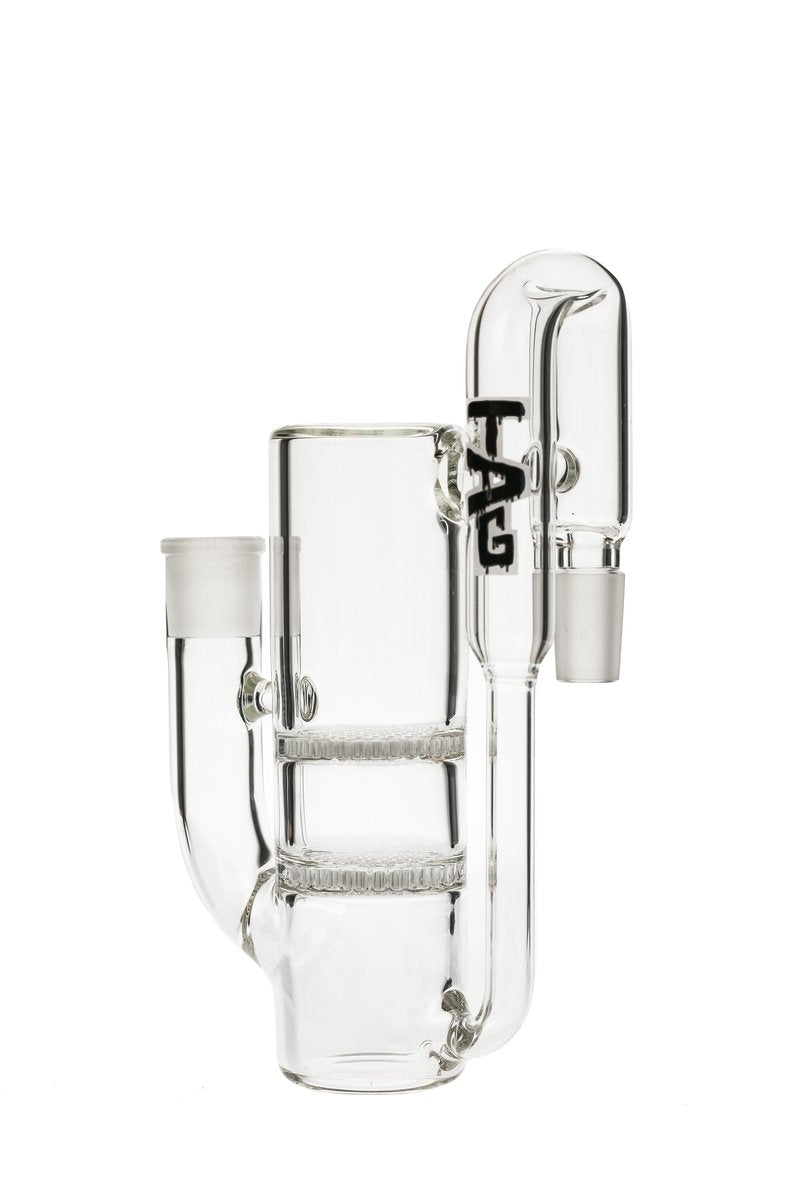Ash catchers do more than just keep your bong clean, they dictate airflow, influence draw resistance, and shape how your session feels from the first pull to the last.
A dry catcher prioritizes simplicity and keeps ash out of your base without introducing water or drag.
A wet catcher adds diffusion and cooling, but brings weight, cleaning complexity, and potential airflow loss.
These differences aren’t cosmetic, they change the way your piece performs. I’ve spent years optimizing airflow and structural integrity in thick glass, and one truth always holds: the smallest component can make or break your experience.
That’s why choosing between a dry and wet ash catcher isn’t trivial, it’s a functional decision with real-world consequences for flavor, smoothness, and long-term maintenance.
In this guide, I’ll break down the tradeoffs so you can choose based on how you actually smoke, not just what looks good or trends online.
The Core Difference: Dry vs Wet Ash Catchers
The terms dry and wet ash catcher get thrown around often, but most people don’t fully grasp what separates the two.
It’s not just a matter of water or no water, it’s about airflow dynamics, filtration intent, and how each one interacts with your piece.
What Is a Dry Ash Catcher?
Dry ash catchers are exactly that, dry. There’s no percolation or bubbling involved.
At most, you’ll find a splash trap at the bottom to catch rogue debris or moisture, but that’s incidental. The function here is simple: intercept ash and plant matter before they reach your bong’s water chamber.
Because there's no water to pull through, dry catchers preserve airflow. That means your draw feels cleaner, faster, and more direct. For glass purists or anyone who values flavor clarity, this is crucial.
Less restriction equals less distortion in taste and less drag on your lungs.
They’re also easy to clean. A dry catcher can be tapped out, rinsed in seconds, and ready for the next session. That simplicity makes them ideal for daily use and travel rigs, especially when time or setup space is limited.
What Is a Wet (Perc) Ash Catcher?
Wet ash catchers incorporate water and often feature percolators, tree, honeycomb, or showerhead styles are common.
This setup creates an additional filtration chamber that helps cool and smooth out your hits.
Functionally, this means a more processed draw. Smoke is diffused through water a second time before it even reaches your bong. The result is reduced harshness and less throat irritation, especially with large bowls or extended sessions.
But this added benefit comes at a cost: increased drag, extra weight, and more cleanup.
Wet catchers also put stress on joints, especially with cheaper or thinner glass. If your bong isn’t built to handle the load, performance, and structural integrity, can suffer.
Pro Tip: Just because it's labeled “dry” doesn’t mean it’s bone-dry. Many dry catchers include a minimal water trap at the base, not for filtration, but to prevent ash blowback and keep cleaning manageable.
Head-to-Head Performance Comparison
Choosing an ash catcher isn’t just about filtration, it's about how your entire setup feels and performs during a session. Every variable matters: how the smoke hits your throat, how hard you have to pull, and what kind of flavor you get on the inhale.
I've built pieces that prioritize every one of these performance factors, and I can tell you, this part of the decision could be the most sensitive one. Let me elaborate.
Smoothness & Cooling
If your priority is smoothness, wet ash catchers are the obvious winner.
By introducing a secondary water chamber with percolation, they actively cool smoke before it hits the main bong. This is especially valuable for anyone who takes larger rips or has a sensitive throat.
The cooling effect is noticeable and immediate.
Dry ash catchers, on the other hand, don’t offer any cooling.
The smoke travels unfiltered through air, straight into your bong’s main chamber. That’s not a design flaw, it’s a design choice. You trade off cooling for clarity and airflow.
If you're someone who values a more direct, unmuted experience, this may be exactly what you want.
Airflow & Drag
This is where dry catchers truly shine. Because there's no percolator or water involved, airflow remains nearly identical to your baseline bong setup.
Pulls are quick, responsive, and require minimal effort. That makes dry catchers ideal for anyone who wants precision control or who gets irritated by restricted pulls.
Wet catchers add resistance, plain and simple.
Even well-designed percs create drag, and with dense options like tree or fritted discs, it becomes significant. That extra filtration may feel great on the throat, but it slows everything down.
You’ll notice longer clear times and more effort on the draw, especially if your lungs are sensitive or your piece already has multiple percs.
Taste & Flavor Preservation
For flavor chasers, dry catchers offer the clearest path. No water means no dilution.
Terpenes remain intact, and what you taste is what you packed, pure, unfiltered, and direct. This is particularly noticeable with vapor or terp-heavy strains.
Wet catchers do improve taste cleanliness, by filtering out resin and burnt particles, but that comes with a cost. Water naturally absorbs aromatics. Subtle notes get flattened, especially during longer pulls.
Practical Issues that Impact the Decision
When people think about ash catchers, they tend to focus on filtration and airflow.
But the practical details, how much weight it adds, how fragile your joint is, how often you’ll need to clean, are what determine whether you actually enjoy using it day to day.
I’ve seen far too many people damage good glass by overlooking these simple factors. If you're serious about optimizing your setup, these next points matter just as much as diffusion or flavor.
Weight & Stress on Joints
Dry ash catchers are structurally safer, especially if you're working with older, thinner, or more delicate bongs.
They’re lighter by design, no percs, no water weight, so the stress they put on your joint is minimal. That makes them compatible with almost any piece, even those not built to carry extra attachments.
Wet ash catchers are another story.
With the added glass mass and water, they can easily stress or even fracture a joint if the piece isn’t built for it. This is especially true with thinner imports or vintage glass that wasn’t engineered for modular accessories.
You wouldn’t believe how many customers we’ve heard from who cracked a joint or downstem by simply attaching a heavy, water-filled perc.
User Worry: “I broke two downstems from using a heavy perc ash catcher on a cheap beaker. Learned my lesson the hard way.”
If you’re running a Thick Ass Glass beaker or straight tube with reinforced joints, you’re going to be better protected, but even then, balance still matters.
Spill Concerns
This is one of the most overlooked issues with wet ash catchers: spillage.
Tilt the piece wrong, clear it too fast, or knock it slightly, and that water goes somewhere it shouldn’t.
We’ve seen people flood their base chamber or soak a carpet mid-session because their ash catcher wasn’t stable.
Dry catchers don’t have this issue. No water, no mess.
That makes them great for travel, group sessions, or just avoiding accidents when you’re moving around. They’re predictable, which in my opinion is underrated when you're smoking.
Cleaning & Maintenance: Which One Saves You Time?
Dry catchers take less than five minutes to clean.
Dump the ash, rinse it under warm water, and you're good. No soaking, no resin caked inside percs.
Wet catchers require real maintenance. Percs clog. Water gets murky fast.
Deep cleaning becomes necessary if you want to keep airflow open. If you’re not prepared for regular upkeep, it gets old fast.
Versatility & Use Case Scenarios
Ash catchers aren’t universal tools. Their value depends entirely on how you smoke and what kind of glass you’re pairing them with.
I’ve built glass for customers who demand clean airflow and fast clears, and others who won’t touch a piece unless it filters like a scientific instrument.
The best ash catcher is the one that fits how you use your setup, not just the one with the most features.
Dry catchers are ideal when efficiency is the goal.
You get debris protection without changing the feel of your bong. The airflow stays wide open, flavor stays crisp, and you’re not dealing with the complications of water or extra filtration.
If your glass is older, thinner, or simply not designed to hold additional weight, a dry catcher makes sense. It’s also the better option for flavor-heavy strains or fast solo sessions where speed and simplicity matter more than ultra-smooth diffusion.
Wet catchers, by contrast, are purpose-built for comfort. The percolation adds drag, yes, but it also takes the sting out of large hits.
When you're running a durable, heavy-duty piece, something with reinforced joints and a wide base, you can accommodate that extra chamber without compromising structure.
These catchers work best in longer sessions, especially with larger bowls or group use, where cooling and filtration are a priority. You’re trading off some immediacy and taste clarity, but gaining a smoother, less abrasive experience.
Buyer’s Checklist: What to Look for Before You Buy
Before you add an ash catcher to your setup, get clear on the specs that actually matter.
A mismatch in joint size, angle, or even weight can ruin performance, or worse, damage your glass. I’ve seen too many customers focus on the wrong features and end up frustrated with something that doesn’t fit or throws off the function of their piece.
If you want your setup to work as a unit, every component has to align, functionally and structurally.
Use the checklist below to make sure you’re choosing the right ash catcher for your needs, not just what looks appealing on the shelf.
✅ Joint Compatibility
Make sure the ash catcher matches your bong’s joint size and type. Common sizes are 14mm and 18mm, and they come in male or female formats. Also confirm the angle: 45° works best for angled necks; 90° is for vertical joints.
✅ Weight & Support
Wet catchers are heavier, especially those with percs and water. If your bong has thin walls or no reinforced joints, stick with a dry catcher to avoid cracks and joint stress.
✅ Percolator Type (For Wet Catchers)
Tree percs offer good diffusion but clog easily and are harder to clean. Showerhead and honeycomb percs are more balanced and often easier to maintain. Choose based on the balance you want between smoothness and maintenance.
✅ Cleaning Accessibility
Can you reach the interior for cleaning? Are the percs open and simple, or are they tucked into tight spots that require soaking and tools?
✅ Materials & Thickness
Prioritize thick, borosilicate glass with reinforced welds, especially if you're going wet. At TAG, we design ash catchers to handle stress over time, with durable welds and strong wall thickness to prevent cracks at connection points.
Considering The Hybrid Path
There’s no rule saying you have to pick one ash catcher and stick with it forever. In fact, a lot of TAG customers rotate between dry and wet depending on the session.
Quick solo hit? Dry catcher, no question.
Long weekend session with friends? Swap in a percolated model for smoother pulls.
The gear should adapt to you, not the other way around.
That’s why we’ve built flexibility into some of our ash catchers. Models like the TAG 90 Degree Removable Downstem Ash Catcher let you choose how you want to run it.
Use it dry for low-maintenance filtration, or add a bit of water to activate percolation. It’s one accessory that gives you both options, without locking you into either.
Every hybrid-compatible TAG piece is built with reinforced joints, precision-fit CAD specifications, and thick borosilicate glass, because if you’re going to run it both ways, it better hold up under the wear.
We’ve engineered these catchers to deliver consistent airflow, whether dry or wet, without compromising durability or balance. That’s the kind of versatility I believe in, purpose-driven, structurally sound, and made to perform across every use case.
Yes, Getting the Right Ash Catcher Is a Big Deal
This isn’t just a question of wet or dry, it’s about how your piece performs every time you light up.
The ash catcher you choose shapes airflow, impacts flavor, changes the feel of the pull, and determines how often you’re cleaning resin off your glass. It’s one of the few add-ons that can either elevate or compromise the entire session.
That’s why it’s worth slowing down and choosing one that fits your setup, your habits, and your expectations.
If you want to see well-built options with real-world utility, modular designs, reinforced joints, and thick glass engineered for actual use, make yourself at home at TAG with an ash catcher for your bong


